![By Vvnataraj (Own work) [CC BY-SA 3.0 (http://creativecommons.org/licenses/by-sa/3.0) or GFDL (http://www.gnu.org/copyleft/fdl.html)], via Wikimedia Commons](https://blog.outdoorherbivore.com/my_wp-content/uploads/2014/01/Snow_covered_path_to_Tungnath-600x399.jpg)
Planning backpacking food for a cold-weather trip is different than for warm weather. You must consider the additional demands of cold temperature places on your body. Extra calories are required to keep the body warm, humidify the air you breathe, and fuel any involuntary shivering. Besides the heavy footwear and clothing you are wearing, the cold weather gear you are carrying on your back (tent, sleep system, extra clothing layers) is also heavier and bulkier, thereby increasing your workload. Trekking in snow places additional physical demands on your body.
Winter backpacking can require an additional 500 – 1,000 calories per day, an average of 4,500 calories per day for men and 3,500 for women. Start planning the right foods before the start of your winter backpacking trip. Eating nutritious foods will make a difference in your ability to stay warm and energized.
Food types
All foods are made up of varying proportions of the three primary food types – carbohydrates, fats, and proteins. There are also vitamins, minerals, and water. The focus here is on the big 3 nutrients (carbs, fats, and proteins) because each one can produce energy, although they do so differently and at different rates. Carbohydrates are the quickest to convert to energy, and fats are the slowest.
Fat provides a slow and steady form of energy, so make sure you get enough in your diet. But do so gradually. A sudden change to a high-fat diet has the potential to cause adverse gastric (heartburn) and metabolic effects, and these symptoms can be difficult to distinguish from a heart attack.
Winter Dietary Percentage | Food Type | Nickname | Food Type Description |
55% | Simple Carbohydrates | kindling | 4 calories/gram – released quickly & provides instant energy, but lacks nutrients. Foods containing sugar ending in “ose” (i.e., glucose, fructose, sucrose, lactose) are simple carbs. Sugar, candy, hot cider, hot cocoa, refined bread/pasta/baked goods made with white flour. Consume the least simple carbs. |
| Complex Carbohydrates | sticks | 4 calories/gram – released quickly & provide fast energy. Easy to digest. Foods containing starch & fiber. Cereal, bread, rice, pasta, dried fruit, beans/lentils, vegetables. Consume the most complex carbs. | |
30% | Fat | logs | 9 calories/gram – released very slowly & provide energy over an extended period; however, fat requires more energy & water to break down lipids (from glycerol) into glucose and fatty acids (from acetyl-CoA) into energy. Nuts, seeds, chocolate, plant fats (olive oil, coconut), cheese, eggs, butter. |
15% | Protein | logs | 4 calories/gram – released slowly & used primarily for cell repair & maintenance of muscle. Not a source of energy unless glucose stores are empty. High protein grains (rice, quinoa, soy, whole grain pasta), nuts, seeds, beans/legumes, tofu/soy. |
Vitamins and Minerals – are present in most foods, and deficiency should not be a concern if you eat a variety of food. For extended backpacking trips (more than 10 days), consider taking supplements to cover the nutrient losses from dried foods, especially if you keep a vegan diet.
Water – drink it often (even if you are not thirsty!). The most critical element for staying ALIVE is WATER. Although not a food type, water is essential for hydration and food digestion. During the winter season, it is common to experience dehydration because there is less humidity in the air, causing a drying effect on the body. You must replace the bodily fluids lost through respiration, evaporation, perspiration, and elimination by drinking water. Generally, this means you must drink 2 – 4 quarts of water daily, depending on your activity level and body size.
- Always fill up water bottles when you cross a water source.
- Consume your water by eating soups and other brothy meals, and make hot beverages such as cocoa or cider at night. Warm drinks (and food) have a pleasant effect on the body when cold outside and help warm you from within.
- Don’t drink icy water. Cold water will lower your internal body heat and give you chills. Keep your bottle of water insulated by covering it with a sock, hat, or similar.
- Cold weather masks your thirst mechanism, so it is common not to feel thirsty. Drink fluids anyway.
- Many backpackers purposefully limit fluid consumption to avoid the hassle of having to pee. Don’t do that — Stay hydrated!
Planning Winter Meals
Hot foods are a favorite choice in the winter. But preparing meals can also be much more challenging and time-consuming. The reason is partly due to the colder air and the fact that you might have to melt snow for your water. This will require increased time to boil, more stove fuel, and better pot insulation.
Freeze-dried one-pot meals are a favorite choice for the trail due to their reduced size, light-weight, and quick preparation, but you can also take purchased foods from the grocery store. Your winter sustenance should not: (1) be too bulky; (2) contain an excessive amount of sodium and protein, which adds metabolic water burden; (3) be susceptible to freezing (i.e., foods with high water content such as fresh foods); (4) require a long cook time.
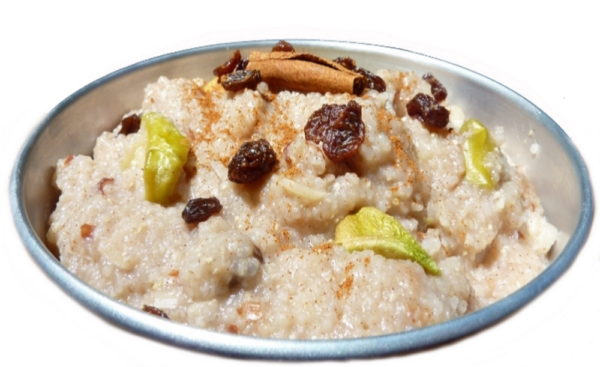
High Elevation Rice Cereal is a warming and filling cereal made with organic instant brown rice farina, dried organic fruit, and nuts.
Breakfast
Breakfast should be a simple and nourishing meal packed with calories to supply energy for a full day of hiking.
A simple breakfast will take up to 10 minutes to prepare. You want to get up and get moving because it’s cold! Lingering around a frigid campsite during the early morning hours will lead to cold feet and body. Breakfast meal suggestions include hot oatmeal, ground semolina, rice farina, or grits with dried fruit, seeds & nuts, hearty cold cereal (such as muesli, granola, or cold soaked oats with chia seed ) with a hot beverage, and instant tofu or egg scramble.
You want to consume small amounts of sugar (simple carbohydrates) in the early morning. Getting an overload of sugar into the bloodstream will cause a hard crash soon into your hike. Overloading on simple carbs is a mistake many hikers make by eating packaged cereal bars, drink mixes, and energy bites, which are high in sugar and poor in nutrition. Always aim to consume close to the ratio of the major food types (see table above) during breakfast – a majority of your calories should come from complex carbs, a few from simple carbs and fat, and some from protein. The added sugar (simple carbs) will help to get you started, and the complex carbohydrates and fat will metabolize slower to keep you energized throughout the morning.

Lunch
Lunch should be a nice break to eat something convenient rather than fiddling with the stove to boil water for a hot meal.
Depending on your preference, you may stop for a long lunch to rest and enjoy the scenery or nibble on finger foods as you walk. Maybe you found a sunny rocky overlook and want to grab a quick bite and take an afternoon siesta to soak in the warmth. Remember that stopping for a prolonged time will lower your core body temperature and make you cold. Insulate the ground before sitting (use a closed-cell foam sleeping mat) and have easy access to an additional clothing layer. You’ll want to add that layer soon after you stop to preserve your core body temperature. Consider snack items such as pita with hummus and cheese or a cold-soak salad if you need to get going quickly.
If you are short on time or are worried about getting cold by stopping, be sure you are snacking during the day to keep your metabolism engaged.

Snack foods
Anything you can munch on while you walk, such as GORP, mixed nuts, dried fruit, dark chocolate, granola, energy bars, bite-size cheese pieces, sesame candy, mini pretzels, hard crackers, and other high-calorie snacks. Just remember not to overdo it on the sugar, including dried fruit. The sugar will give you a quick spike of energy and warm you, but then your body temperature will fall suddenly once it is burned off. Sometimes this can cause your body temperature to drop below its previous level.
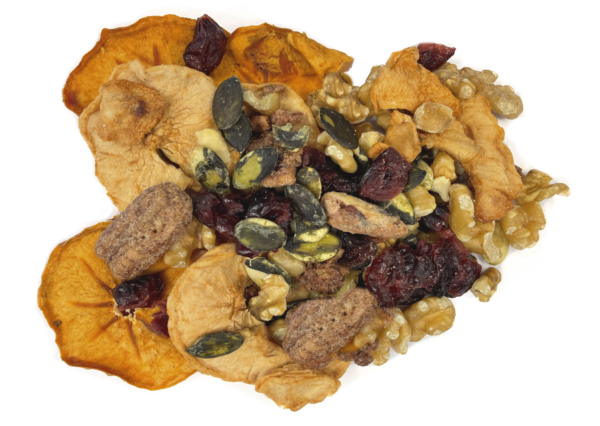
Dinner
The last meal of the day is often considered the grand finale. You earned it. It should be interesting, taste good, and make you feel warm and satisfied before falling asleep.
In the winter, start dinner by sipping hot tea, cocoa, or soup. This helps warm you as the sun begins to lower on the horizon. Sipping also holds your interest while you prepare dinner in the cold. Your body will get cold quickly once you stop, so it is a good idea to make something hot right away.
The main dish in the winter frequently involves a one-pot meal rich in complex carbohydrates. Look for meals containing wholesome starches (wholegrain pasta, rice, quinoa, couscous) with a soupy base, an assortment of dried vegetables, and dried pre-cooked beans/lentils for protein. And don’t forget to add the fat (olive oil, nuts, seeds, cheese) because it works wonders to keep you warm as you sleep.
Dinner suggestions include pasta with a thick vegetable-based sauce, bean chili, lentil soup, rice with vegetables & nuts, couscous with dried fruit & nuts, and instant quinoa with beans & vegetables.
Dessert
Concluding your final meal of the day with a dessert is optional, but we do recommend you eat something extra if you ate dinner early. About an hour before you fall asleep, eat something rich in fat calories that will help you stay warm through the night.
A dark chocolate bar is a good option if you don’t want to heat up anything. If you decide to fire up the stove, use any warm water left in the cooking pot. Reheat the water, pour it into wide-mouth bottles, and bring them into your sleeping bag. They’ll warm your bag and act as personal water heaters when sleeping. A bonus: you are guaranteed to have pourable water (not frozen) the following morning, allowing you a hassle-free quick breakfast/coffee morning routine.
Additional guidelines for winter backpacking food & cooking:
- Don’t pack fresh food in the winter or ready-made wet-pack meal pouches. These all contain water (subject to freezing) and weigh a lot (you have enough to carry). The exception is foods rich in oils (such as avocados and olives) or plant-based oils (olive oil), which are needed for higher fat. The packets of vegetable oil are prone to freeze but will not be damaged if they do. You can easily make them viscous by warming them between the hands. Take instant dry grains (pasta, rice, oats), baked goods (bagels, bread, crackers, cookies), and backpacking meals (more expensive but lightweight, easy, quick, and saves on stove fuel).
- Pack meals that taste extra good. Your appetite diminishes during winter activity (even though the body’s food needs have increased), so make sure the food you pack is something you LIKE to eat. If the meal isn’t appealing to you before your trip, it will probably not be during it. In some situations, you will need to make yourself eat, even if you are not hungry.
- Check the portion size. If you purchase dried meals from a new company, it is always a good idea to test the food before you hike. Make sure the portion size claimed will be enough for you to eat. Many backpacking food companies overestimate what constitutes a hiker’s appetite, particularly a thru-hiker.
- Food packaging should be flat, flexible, and watertight. Repack your food items before your trip to minimize carrying any extra waste. Then combine all the meals by type or another system that works for you. We recommend combining “like” meals into separate bags (breakfast, lunch, snack, dinner, and dessert/hot drink)—Mark the bag to be recognizable.
- Minimize utensil needs. You only require a large cup (which acts as a bowl and mug; insulated is best) and a plastic spoon (metal isn’t recommended for winter). If you are in the snow, it might be a good idea to tie a string between the cup and the spoon. Spoons get lost when dropped in the snow.
- Keep stove lighters warm & dry by stowing them in pockets. Keep a spare lighter in your first aid kit. Electric lighters are more reliable than flint lighters and are often refillable.
- Winterize your cooking stove. Make sure your backpacking stove is equipped with a wind guard or windscreen. Use a reflector if necessary. Always boil and reconstitute dried foods in a lidded pot. See also cooking to conserve fuel.
- Relax with dish duty. Improper cleaning during frigid temperatures has one advantage – no mold. We don’t recommend packing up dirty dishes, but you can slack off in cleaning. Leaving bits of food residue is acceptable. If you are paranoid about germs, a quick rinse is sufficient. Soaping and scrubbing are unnecessary, especially if snow is on the ground. Snow makes for a good cleaning – use it to scrape off leftover food residue. Wear waterproof gloves (rubber, latex) when doing dishes to protect your hands.
Related Posts:
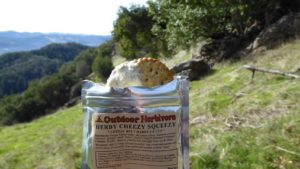
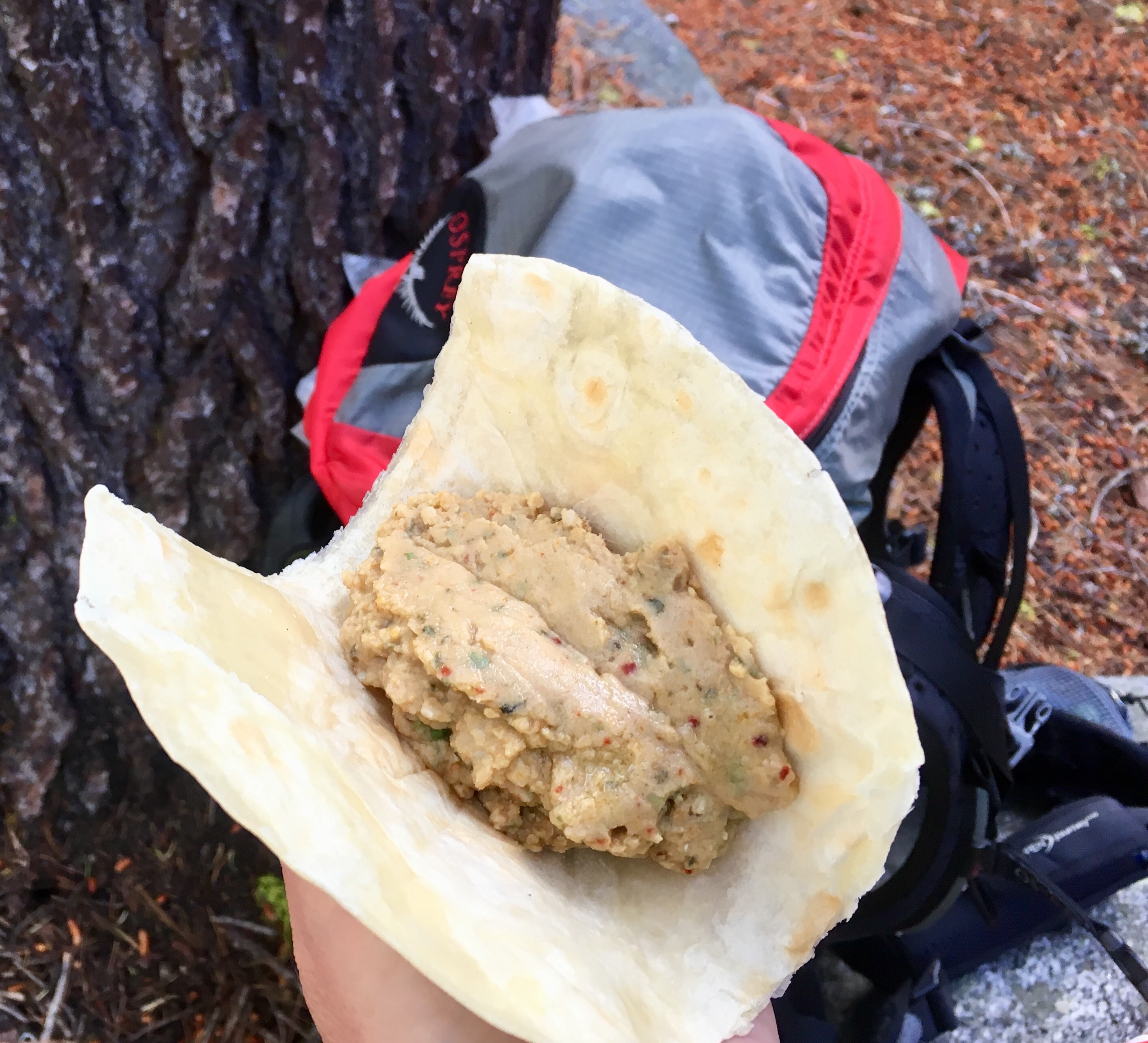
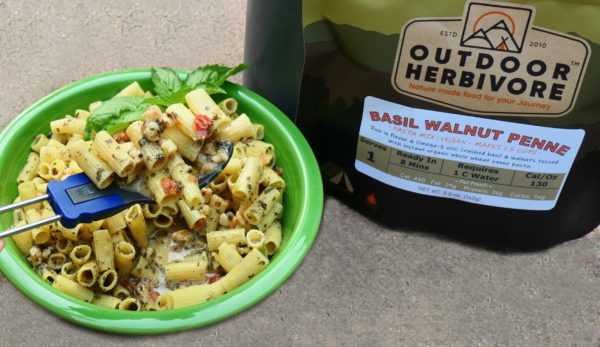
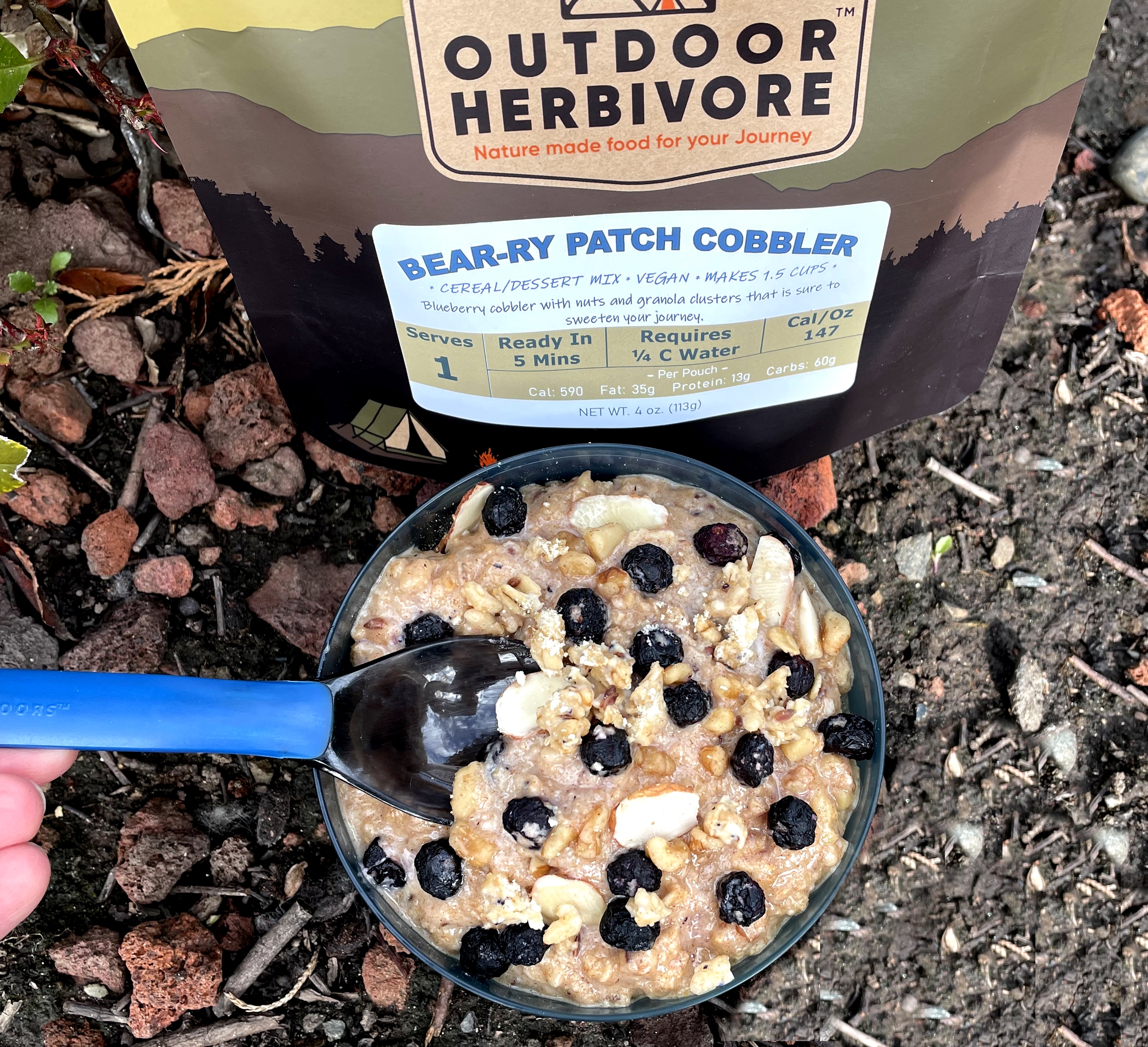
8 thoughts on “Foods You Need to Eat when it is Cold Outside”
“the big three nutrients – carbs, fats and proteins – because each one can convert into simple sugars to produce energy”
FYI, actually, fats are not metabolized by first being converted to glucose and this is also true for most protein that is “burned.”
Another great, informative article! Thanks for your work!
A great article packed with a lot of crucial backcountry cooking and eating tips! Thank you!
ww
good article.
Relax with dish duty. Improper cleaning during frigid temperature has one advantage – no mold. We are not recommending that you forgo cleaning dishes, but you can get by with letting bits of food residue remain (saved calories for your next meal). If you are paranoid about germs, a quick rinse is fine. Soaping & scrubbing is really not necessary, especially if there is snow on the ground. Snow makes for a good cleaning – use it to scrape off leftover food residue. Wear waterproof gloves (rubber, latex) when doing dishes to protect your hands.
good suggestions especially the dessert/Fair trade dark chocolate with coconut cream, chia, and organic dried blueberries.
Hello, I am just having my first winter in Central Portugal (Cidral,Monsanto, Idanha-a Nova) You blog has just cut down my heating bill hahahaha Obrigada (Thank You)